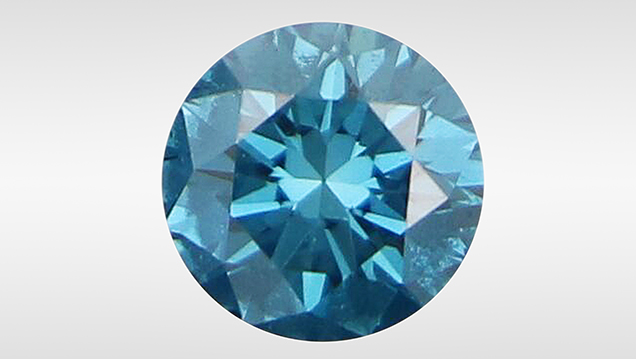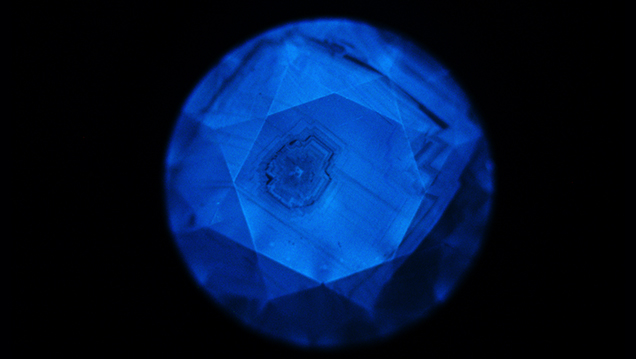Irradiated and Annealed Blue Type Ia Diamond

Many diamonds are subjected to artificial radiation, usually with subsequent annealing to create attractive colors. Most blue diamonds in the market are treated by artificial irradiation, yet irradiated blue diamonds with a multi-step treatment process are rarely seen in the lab. The National Center of Supervision and Inspection on Quality of Gold and Silver Products (Nanjing, China) recently examined such an example.

The 0.36 ct round brilliant, graded as fancy deep green-blue (figure 1), had natural mineral inclusions under the table and a fracture near the girdle. The DiamondView image showed a ring-like natural growth pattern (figure 2). The infrared spectrum revealed the diamond was type IaAB, with absorptions at 1282 cm–1 and 1175 cm–1 (A-aggregated nitrogen and B-aggregated nitrogen, respectively); the spectrum also revealed a radiation-related peak at 1450 cm–1 (figure 3). The H1a center reflected by the 1450 cm–1 band, involving a single nitrogen atom and two equivalent carbon atoms, was formed by irradiation and annealing above 300°C for diamonds with aggregated nitrogen (type Ia) (I. Kiflawi et al., “Nitrogen interstitials in diamond,” Physical Review B, Vol. 54, No. 23, 1996, pp. 16719–16726). The UV-Vis-NIR absorption spectrum showed absorption from a GR1 defect at 741.2 nm and revealed weak absorptions from a defect of uncertain structure (594.4 nm), H3 (503.2 nm), and H4 (496.2 nm) centers (figure 4). The GR1 center, believed to be a neutral vacancy (V0) defect, is a typical radiation-induced defect; the vacancies begin to move at 500°C and the GR1 center begins to decrease until it disappears, at around 800°C (A.T. Collins, “Investigating artificially coloured diamonds,” Nature, Vol. 273, No. 5664, 1978, pp. 654–655). The 595 nm center is also a typical radiation-induced center, which appears at temperatures above 300°C after radiation (Collins et al., 1978). The presence of the H3 and H4 centers was confirmed with photoluminescence (PL) spectroscopy (figure 5). The combination of all the above defects, especially the strong H1a center, indicates that the diamond was subjected to irradiation followed by annealing.



Natural near-colorless type Ia diamonds are known to be artificially irradiated to introduce blue to green color by displacing carbon atoms in the lattice to create vacancies. Annealing could be used to change the lattice defect configuration, especially GR1, to achieve a purer blue (C.M. Breeding, “A spectroscopic look at green and blue gem diamonds colored by artificial irradiation treatment,” presentation at Geological Society of American 2014 annual meeting). After annealing above 500°C, the vacancies start to migrate, and can be captured by nitrogen centers to create the H1a center (B. Dischler, Handbook of Spectral Lines in Diamond, Volume 1: Tables and Interpretations, Springer-Verlag, Berlin, 2012, pp. 315–316). To the best of our knowledge, this is the first diamond examined in China that has been irradiated and annealed to introduce a blue color.



